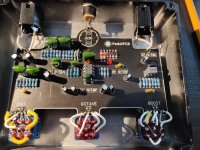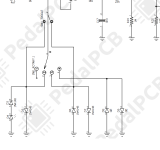joeyd
Well-known member
I've read through a litany of Parentheses troubleshooting threads and I haven't quite been able to sort out the issue I'm having - as I turn my octave pot clockwise it cuts my volume. As far as I can tell I've got my resistors in the correct locations. Here's what my transistors are reading (from what I've read many of these values aren't correct but I'm not sure how to use them to troubleshoot my issue):
Q1:
drain: 8.85v
source: 0.87v
gate: 0v
Q2:
emitter: 0.25v
base: 0.8v
collector: 6.3v
Q3:
emitter: 8.85v
base: 0v
collector: 0v
Q4:
emitter: 3.79v
base: 0v
collector: 8.85v
Q1:
drain: 8.85v
source: 0.81v
gate: 0v
I'm not having any issues with the boost or distortion side - they sound great (although op-amp and si/led clipping options sound identical). It's also worth mentioning that I sourced my transistors from Stompboxparts and Amplified Parts (not Ebay, Amazon, AliExpress, etc.).

Q1:
drain: 8.85v
source: 0.87v
gate: 0v
Q2:
emitter: 0.25v
base: 0.8v
collector: 6.3v
Q3:
emitter: 8.85v
base: 0v
collector: 0v
Q4:
emitter: 3.79v
base: 0v
collector: 8.85v
Q1:
drain: 8.85v
source: 0.81v
gate: 0v
I'm not having any issues with the boost or distortion side - they sound great (although op-amp and si/led clipping options sound identical). It's also worth mentioning that I sourced my transistors from Stompboxparts and Amplified Parts (not Ebay, Amazon, AliExpress, etc.).


